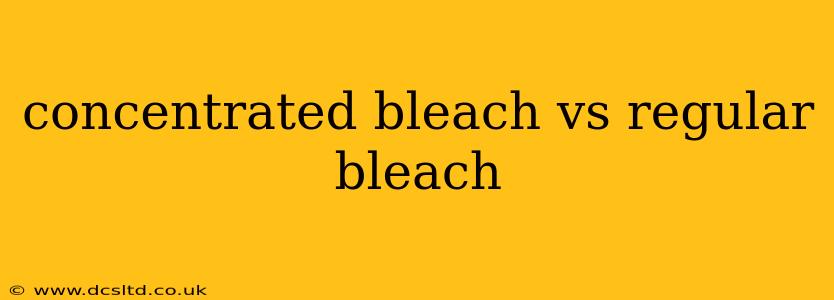Bleach is a common household cleaning agent, but not all bleaches are created equal. Understanding the difference between concentrated bleach and regular bleach is crucial for safe and effective cleaning. This article will delve into the key distinctions, helping you choose the right bleach for your needs and ensuring safe handling practices.
What is Concentrated Bleach?
Concentrated bleach, also known as high-concentration bleach or industrial bleach, contains a significantly higher percentage of sodium hypochlorite (the active bleaching ingredient) than regular household bleach. While regular bleach typically contains around 5-6% sodium hypochlorite, concentrated bleach can range from 8% to even 15%. This higher concentration means it’s more potent and effective at bleaching and disinfecting, but it also poses a greater risk if handled improperly.
What is Regular Bleach?
Regular bleach, the type commonly found in supermarkets and grocery stores, is a diluted solution of sodium hypochlorite. Its lower concentration makes it safer for household use, although it's still essential to handle it with care. The lower concentration means it's less aggressive on fabrics and surfaces, making it suitable for a wider range of cleaning tasks.
Concentrated Bleach vs. Regular Bleach: Key Differences
Here's a table summarizing the key differences:
| Feature | Concentrated Bleach | Regular Bleach |
|---|---|---|
| Sodium Hypochlorite Concentration | 8-15% (or higher) | 5-6% |
| Effectiveness | More potent for bleaching and disinfecting | Less potent, but safer for household use |
| Safety | Requires more cautious handling | Still requires careful handling |
| Cost | Generally more expensive per unit volume | Less expensive per unit volume |
| Applications | Industrial cleaning, heavy-duty bleaching | General household cleaning, laundry |
What are the Uses of Concentrated Bleach?
Concentrated bleach finds its applications primarily in industrial settings and commercial cleaning. Its higher potency makes it ideal for:
- Industrial Cleaning: Sanitizing large areas, equipment, and surfaces where heavy-duty disinfection is required.
- Heavy-Duty Bleaching: Removing stubborn stains from fabrics or surfaces that regular bleach may not tackle effectively.
- Pulp and Paper Production: A crucial component in the bleaching process for paper production.
Important Note: Always follow the manufacturer's instructions carefully when using concentrated bleach. Improper handling can lead to serious health hazards.
What are the Uses of Regular Bleach?
Regular bleach is a versatile cleaning agent suitable for various household tasks:
- Laundry: Whitening and brightening clothes, removing stains.
- Bathroom Cleaning: Disinfecting toilets, sinks, and shower surfaces.
- Kitchen Cleaning: Sanitizing countertops and other surfaces.
- Mold and Mildew Removal: (Use with caution and proper ventilation.)
Important Note: Never mix bleach with other cleaning agents, especially ammonia or acids, as this can create toxic gases. Always dilute bleach according to product instructions.
Is Concentrated Bleach Necessary for Household Cleaning?
For most household cleaning tasks, regular bleach is sufficient. The higher concentration of concentrated bleach isn't necessary and can even be detrimental due to the increased risk of damage to surfaces and potential health hazards.
Safety Precautions When Using Bleach
Regardless of the concentration, always handle bleach with caution:
- Wear protective gloves and eyewear: Protect your skin and eyes from contact.
- Work in a well-ventilated area: Bleach fumes can be irritating.
- Never mix bleach with other cleaning products: This can create dangerous chemical reactions.
- Store bleach out of reach of children and pets: Keep it in its original container and away from heat sources.
- Dispose of bleach properly: Follow local regulations for proper disposal of hazardous waste.
By understanding the differences between concentrated bleach and regular bleach, and by following safety precautions, you can utilize bleach effectively and safely for your cleaning needs. Remember to always read and follow the manufacturer's instructions on the product label.
